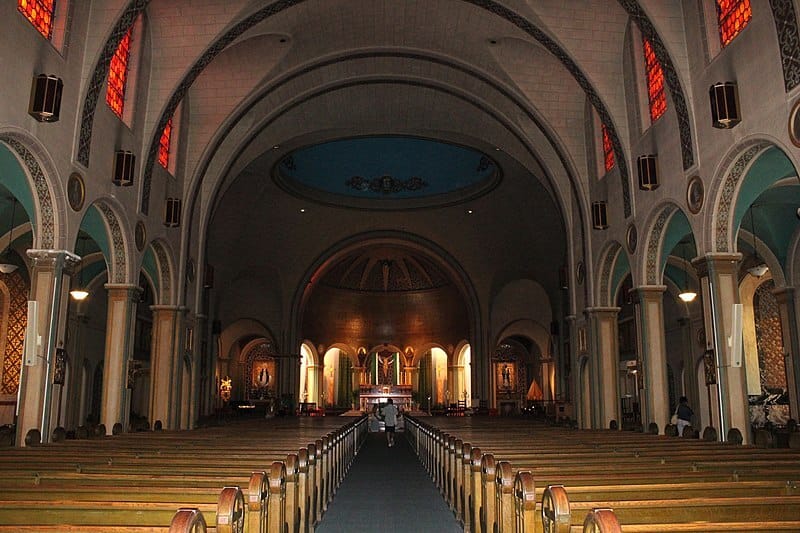
At Mission Dolores Basilica, the bones of thousands lie hidden beneath your feet.
Sure, you can marry your fiancé in the Mission Dolores basilica, but should you? If you knew what really happened there, would you?
Mission Dolores is a monument to the massacre of San Francisco’s true Natives. You shouldn’t want to get married there. Unfortunately, desecrating sites of unspeakable human tragedy is not a new fad. The practice of plantation weddings comes to mind, which is hopefully on its way out.
Do not wed at Mission Dolores. No God smiles on a marriage founded on the slaughter of thousands. If you wish to have your nuptials at a holy venue, consider any other church. I hear autumn ceremonies at the Satanic Temple in Salem, Massachusetts are quite lovely. If you’re still not sure why marrying at Mission Dolores (or any of California’s other twenty-one Spanish missions) is the wrong move, let’s get into why. First,
You Won’t Absolve Yourselves With Some Pithy Land Acknowledgement.
And let’s face it: you probably won’t even get that right. Who belongs to the land you’re on? In San Francisco, you’re on Yelamu Ohlone territory.
“Yelamu” is the name Ohlone speakers gave to the people living in modern-day San Francisco. It loosely translates to “Western People,” and comes from the Chochenyo Ohlone of the East Bay.
The Yelamu were among the first Bay Area Natives to encounter Spanish missionaries and conquistadors. Subsequently, they were the first to be imprisoned at the Misión de San Francisco de Asís, or Mission Dolores.
Most if not all of the Yelamu were slain or died by disease and starvation in the mission’s early years. Their closest relatives, the Ramai (Ramaytush) of today’s San Francisco Peninsula, barely escaped the same fate. Their direct descendants survive today.
That is why most maps of the Native Bay Area omit the Yelamu or subsume them under their Ramaytush relatives. There are no known direct descendants of the Yelamu.
For those raised in California, mission sites were part of the scenery, no more out-of-place than palm trees and freeways. Your fourth-grade teacher likely had an interactive unit on the subject in which you built replicas from sugar cubes. Only recently has this morbid exercise begun to fade from popularity.
The Spanish enslaved the people they abducted and forced them to construct their own prisons. Some revolted and were quickly executed. Others were thrown to captive, starved dogs. Second only to the punishing cruelties enacted by their overseers were the tolls exacted by their invisible companions. A majority of imprisoned, or “missionized” people, suffered and died from illnesses to which they had no natural immunities.
You’d Be Consecrating Your Marriage On a Site of Concentrated Genocide
Mission Dolores today more accurately reflects the dioramas made in its name. Bibles large enough crush families if made to scale dangle over flower-lined pathways to yawning ornate archways. Manicured shrubs hug the basilica’s waist, its ornate churrigueresco façade sometimes rendered in sandpaper or clay. The models fail to mention Father Junipero Serra’s role in perpetrating mass murder and enslavement; so do the walls of Mission Dolores.

Father Junipero Serra depicted at Mission Dolores as a savior of the Ohlone-speakers.
At 16th and Dolores, the disembodied bones of five thousand people abducted from their homes lie just beneath your feet. Only some of their locations are marked. Rumors of remains buried within the original structure’s adobe walls hardly gussy up what is already perfectly disturbing. The rationale behind the fourth-grade mission project’s overextended stay draws out the very flaws is in the unit’s ideology:
“According to the framework from the state Department of Education, while Native Americans were initially attracted to the missions with food, wealth and the ‘pageantry’ of the Catholic Church, they were forced to stay and work for the Spanish explorers, building presidio fortresses, cattle ranches and pueblos.” —Cameron Kizsla, KTLA, Jul. 11, 2022
By 1833, an estimated 62,000 people had been exterminated in California’s missions. The state wasn’t ratified until 1850. By the turn of the twentieth century, a number of tribes had been systematically reduced to double-digit numbers. The mission system was a machine designed to consume Indigeneity and regurgitate corpses and converts, or neophytes. Yet, the insulting simplification and passive voice of the state Department of Education’s description makes it sound organic and patient as a Venus flytrap.
The theme of your marriage will be “Suffering.”
Many places nearby bear the name “Dolores,” the church, the park, a street and a school district—even the creek that once ran nearby. The original mission was a long, squat structure with terra-cotta roofing requisitioned in 1776, year of someone else’s independence.
The English word for dolor is “pain,” usually physical, sometimes spiritual. Dolores often means long, drawn-out suffering. In Christianity it points to the agonies of Jesus on the Cross, of Mary witnessing her son’s crucifixion. Plurality implies a multitude of reasons to weep.
Why would the Spanish call the arroyo that once flowed nearby the Creek of Sorrows? Why name the mission after it? Who wept there so often that the physical place is tied to an emotion?
And why the hell would you want to get married there?
History won’t look kindly on your wedding photos.
The choice to marry on the site of an ethnic cleansing looks bad for posterity. The way things are going, it may end up looking like you got married at Auschwitz. Would you profess and dedicate your love in such a place? For now, the ornamentation masks the mission’s ill intentions. Cool tones like Moroccan hash-brown and lapis-lazuli conceal its bloodied past. A small array of endemic plants stand in modest memorial of what and who truly belongs here. Notice your wedding bouquet not among them.
It’s not a question of whether you can get married at Mission Dolores. It’s whether you should.
The post Should You Get Married at Mission Dolores Basilica? appeared first on Broke-Ass Stuart's Website.









